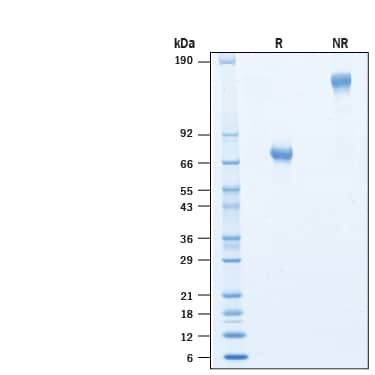Recombinant Human TNF RII/TNFRSF1B Fc Avi-tag Protein, CF
R&D Systems, part of Bio-Techne | Catalog # AVI10911

Key Product Details
Source
Accession #
Structure / Form
Conjugate
Applications
Product Specifications
Source
| Human TNF RII/TNFRSF1B (Leu23-Asp257) Accession #AAA36755.1 |
IEGRMD | Human IgG1 (Pro100-Lys330) |
Avi-tag |
| N-terminus | C-terminus | ||
Purity
Endotoxin Level
N-terminal Sequence Analysis
Predicted Molecular Mass
SDS-PAGE
Activity
When Recombinant Human TNF alpha (Catalog # 210-TA) is coated at 0.100 μg/mL (100 μL/well), Biotinylated Recombinant Human TNF RII/TNFRSF1B Fc Chimra Avi‑tag binds with an ED50 of 4.00-24.0 ng/mL.
The biotin to protein ratio is greater than 0.7 as determined by the HABA assay.
Scientific Data Images for Recombinant Human TNF RII/TNFRSF1B Fc Avi-tag Protein, CF
Biotinylated Recombinant Human TNF RII/TNFRSF1B Fc Chimera Avi-tag Protein SDS-PAGE.
2 μg/lane of Biotinylated Recombinant Human TNF RII/TNFRSF1B Fc Chimera Avi-tag Protein (Catalog # AVI10911) was resolved with SDS-PAGE under reducing (R) and non-reducing (NR) conditions and visualized by Coomassie® Blue staining, showing bands at 68-81 kDa and 140-160 kDa, respectively.Formulation, Preparation and Storage
AVI10911
| Formulation | Lyophilized from a 0.2 μm filtered solution in PBS with Trehalose. |
| Reconstitution | Reconstitute at 500 μg/mL in PBS. |
| Shipping | The product is shipped at ambient temperature. Upon receipt, store it immediately at the temperature recommended below. |
| Stability & Storage | Use a manual defrost freezer and avoid repeated freeze-thaw cycles.
|
Background: TNF RII/TNFRSF1B
Tumor Necrosis Factor Receptor II (TNF RII), also known as TNFRSF1B, p75/p80, and CD120b, is a type I transmembrane protein that belongs to the TNF receptor superfamily (1-4). The TNF receptor superfamily is comprised of structurally related receptors that bind to TNF-related ligands and regulate numerous processes such as immune cell activation and apoptosis. Receptors in this superfamily are characterized by the presence of a cysteine-rich region in their extracellular domain (ECD) (1-3, 5). Human TNF RII shares 57% and 56% sequence identity in the ECD with its mouse and rat homolog. Several receptors in the TNF superfamily also contain intracellular death domains (DDs) that recruit caspase-interacting proteins to initiate apoptosis upon ligand binding. Those receptors that lack DDs, like TNF RII, bind TNF Receptor-associated Factors, which transduce signals generated by activation of these receptors (6, 7). TNF RII is expressed predominantly on cells of the hematopoietic lineage, such as T and natural killer cells, as well as on endothelial cells, microglia, astrocytes, neurons, oligodendrocytes, cardiac myocytes, and thymocytes (6, 8, 9). TNF RII activation primarily initiates pro-inflammatory and pro-survival responses via NF kappa B-dependent signaling pathways (6, 7). However, under certain conditions, TNF RII signaling can induce apoptosis (8). Soluble TNF RII is believed to inhibit TNF biological activity by binding TNF thereby preventing it from activating membrane TNF receptors (10).. Our Avi-tag Biotinylated human TNF RII/TNFRSF1B Fc Chimera features biotinylation at a single site contained within the Avi-tag, a unique 15 amino acid peptide. Protein orientation will be uniform when bound to streptavidin-coated surface due to the precise control of biotinylation and the rest of the protein is unchanged so there is no interference in the protein's bioactivity.
References
- Dembic, Z. et al. (1990) Cytokine 2:231.
- Kohno, T. et al. (1990) Proc. Natl. Acad. Sci. USA 87:8331.
- Lewis, M. et al. (1991) Proc. Natl. Acad. Sci. USA 88:2830.
- Loetscher, H. et al. (1990) J. Biol. Chem. 265:20131.
- Beltinger, C.P. et al. (1996) Genomics 35:94.
- Faustman, D. and M. Davis (2010) Nat. Rev. Drug Discov. 9:482.
- Ihnatko, R. and M. Kubeš (2007) Gen. Physiol. Biophys. 26:159.
- Mason, A.T. et al. (1995) J. Leukoc. Biol. 58:249.
- Speeckaert, M.M. et al. (2012) Am. J. Nephrol. 36:261.
- Sennikov, S.V. et al. (2014) Mediators Inflamm. 2014:745909.
Long Name
Alternate Names
Gene Symbol
UniProt
Additional TNF RII/TNFRSF1B Products
Product Documents for Recombinant Human TNF RII/TNFRSF1B Fc Avi-tag Protein, CF
Product Specific Notices for Recombinant Human TNF RII/TNFRSF1B Fc Avi-tag Protein, CF
For research use only
